This article on the D7 chord will give you an overview of its music theory, chord scales, distribution of the chord tones along the fretboard, its open, movable, and barre shapes, layout on the Piano Keyboard, etc.
Read the complete article to know all about the D7 chord!
Music Theory, Notes & Intervals Of The D7 Chord
You can familiarize yourself with the music theory associated with the dominant seventh chords in brief in the section below.
- The Dom7 chords have the intervals of Major 3rd, minor 3rd, and minor third stacked over the root notes.
- These chords exhibit dominant function with a strong urge to resolve the tonic chords of the scales. Hence they find use in songs and other musical compositions in blues, jazz, pop, and other forms of popular music.
- The notes of the D7 chord are [D, F#, A, and C]. These notes are at the scale degrees [5, 7, 2, and 4] of the G major scale.
D7 Chord Scales
The D7 dominant chord is naturally occurring in the scales listed below:
- G Major Scale and its modes.
- G Melodic Minor Scale and its modes.
- A Melodic Minor scale and its modes.
- G Harmonic Minor scale and its modes.
- G Harmonic Major scale and its modes.
How To Play The D7 Chord
You will now learn how to play the D7 guitar and D7 piano chords.
Map Chords Along All The Fretboard
The below diagram shows the chord notes of the D7 guitar chord laid on the guitar fretboard on all the strings.
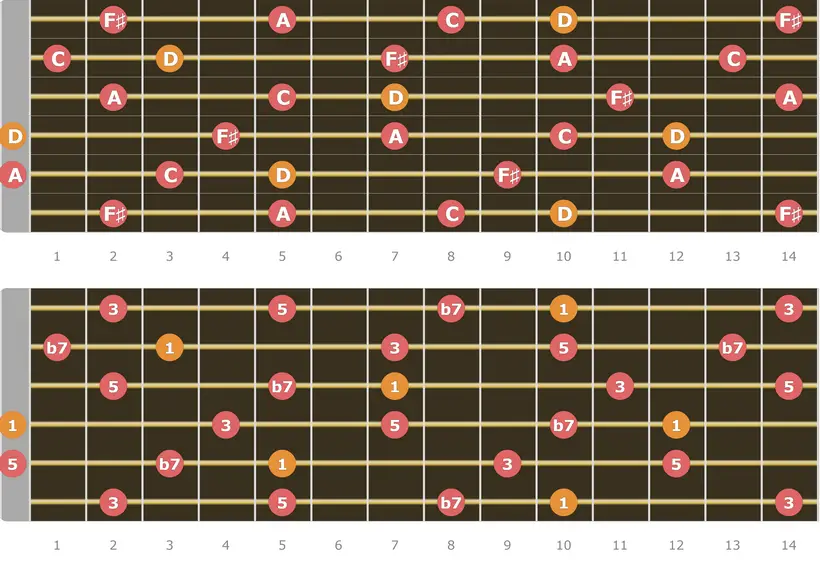
D Dominant Seventh Chord – Guitar Chord Shapes And Fingerings
You can now go through the most common ways to play the D7 guitar chord. The finger positions are also suggested in the chord diagrams below. As with other guitar chords, you can play D7 in open, moveable, and barre chord voicings.
The numbers in the black circles in these diagrams indicate the fret positions, while those in the red circles on the fretboard indicate the recommended fingers for guitar playing.
Here
- 1 – Index or the First Finger,
- 2 – Middle or the Second Finger,
- 3 – Ring or the Third finger,
- 4 – Little or the Fourth Finger.
The strings marked ‘X’ are to be skipped or muted, while those marked ‘O’ are to be played in the open position.
Open Position
The three open positions for the D7 chord are explained below:
- O1 – Construction – (x – x – 0 – 2 – 1 – 2). Notes – (1, 5, b7, and 3).
- O2 – Construction – (x – 0 – 0 – 2 – 1 – 2). Notes – (5, 1, 5, b7, and 3). This chord voicing is similar to O1, except for the open A string. This has A as the bass note.
- O3 – Construction – (x – 3 – 0 – 2 – 3 – 2). Notes – (b7, 1, 5, 1, and 3). The voicing has C as the bass note.
O1
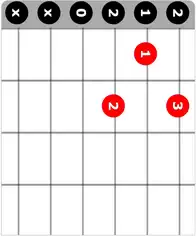
O2
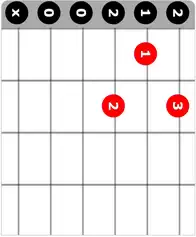
O3
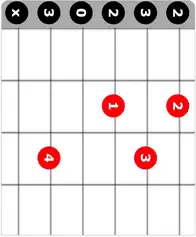
Movable Positions
The eight movable chord shapes are described below for a better understanding of beginners.
- M1 – Construction – (x – 5 – 4 – 5 – x – x). Notes – (1, 3, and b7). The shape has an omitted fifth note.
- M2 – Construction – (x – 5 – 4 – 5 – 3 – x). Notes – (1, 3, b7, and 1). Omitted 5th note.
- M3 – Construction – (x – x – 4 – 5 – 3 – 5). Notes – (3, b7, 1, and 5). F# is the bass note.
- M4 – Construction – (10 – x – 10 – 11 – x – x). Notes – (1, b7, and 3). Omitted 5th note.
- M5 – Construction – (10 – x – 10 – 11 – 10 – x). Notes – (1, b7, 3, and 5).
- M6 – Construction – (x – x – 12 – 11 – 13 – 10). Notes – (1, 3, b7, and 1). Omitted 5th note.
- M7 – Construction – (x – x – 12 – 14 – 13 – 14). Notes – (1, 5, b7, and 3).
- M8 – Construction – (14 – x – 12 – 14 – 13 – x). Notes – (3, 1, 5, and b7). F# is the bass note.
M1
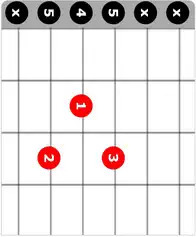
M2
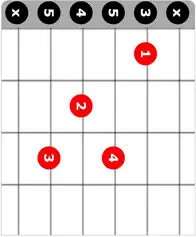
M3
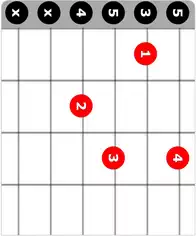
M4
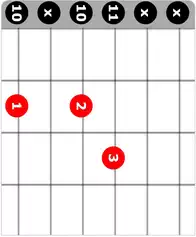
M5
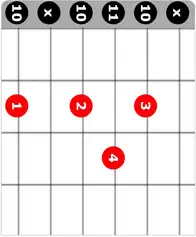
M6
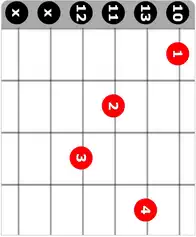
M7
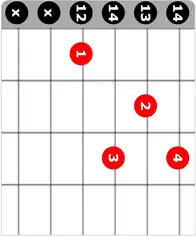
M8
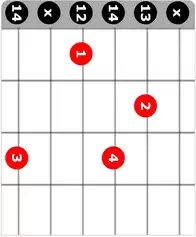
Barre Chords
The seven Barre chord versions are explained below:
- B1 – (5, b7, 1, and 3). A is the bass note in the open position.
- B2 – (5, 1, 3, and b7). In this familiar voicing, the seventh of the chord is fretted on the high E string by the ring finger.
- B3 – (1, 5, b7, 3, and 5).
- B4 – (b7, 5, 1, and 3). C is the bass note in this shape. The root is on the G string.
- B5 – (b7, 3, 5, and 1). The root note is on the high e string, and C is the bass note.
- B6 – (1, 5, b7, 3, 5, and 1). Open E7-shaped voicing.
- B7 – (1, 5, b7, 3, b7, and 1).
B1
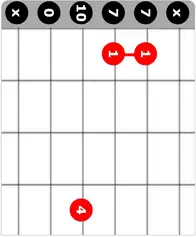
B2
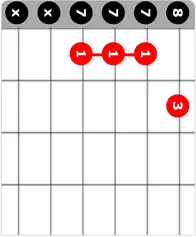
B3
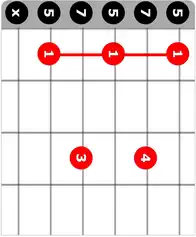
B4
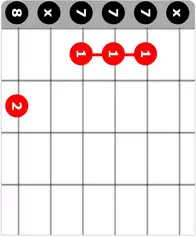
B5
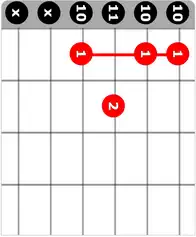
B6
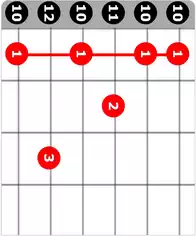
B7
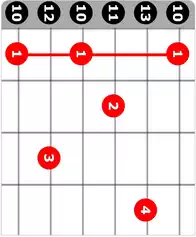
Chord Diagrams – D7 Chord Inversions
The chord inversions I1, I2, and I3 of the D7 chord are shown in the chord diagrams below.
- First Inversion D7/F# with notes [F# A C D]. The Bass note is F#.
- Second Inversion D7/A with notes [A C D F#]. The lowest note is A.
- Third Inversion D7/C with notes [C D F# A]. The Bass note is C.
I1
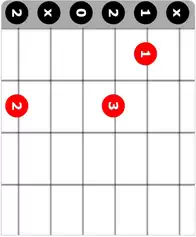
I2
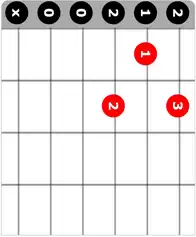
I3
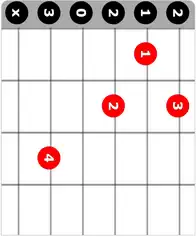
D7 Chord Piano With Keyboard Diagram.
The keyboard diagram for the D7 chord is shown in the root position below. Red circles mark the notes.

Fingering Arrangement
- Right Hand – 1 – 2 – 3 – 5.
- Left Hand – 5 – 3 – 2 – 1
The thumb is designated as ‘1’ and the little finger ‘5’ for both hands.
First Inversion
The keyboard diagram for the D7/F#, the first inversion, is shown below.

Fingering Arrangement
- Right Hand – 1 – 2 – 4 – 5.
- Left Hand – 5 – 3 – 2 – 1
Second Inversion
The keyboard diagram for the D7/A, the second inversion, is shown below.

Fingering Arrangement
- Right Hand – 1 – 2 – 3 – 5.
- Left Hand – 5 – 3 – 2 – 1
Third Inversion
The keyboard diagram for the D7/C, the third inversion, is.

Fingering Arrangement
- Right Hand – 1 – 2 – 3 – 5.
- Left Hand – 5 – 4 – 2 – 1
Conclusion
We hope that this lesson will help in your guitar journey as you now have a clear idea of how the D7 chord is played over different sections of the fretboard. Prepare a practice routine and play them regularly. Provide your comments in the section below.
